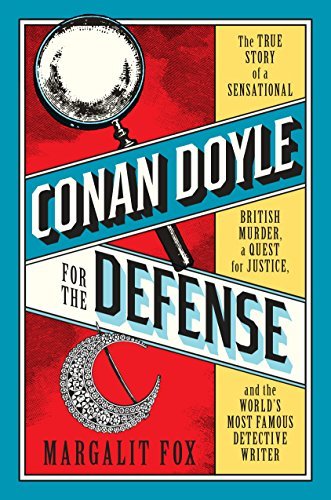
Sir Arthur Conan Doyle is known to most of us as the author of the sixty Sherlock Holmes tales. But Conan Doyle was a truly remarkable man in many other ways as well. He was an accomplished physician specializing in ophthalmology. He was knighted not because of his writing talent but because he had performed heroic service for the Crown in the Boer War. During World War I, “he busied himself . . . in creating what became a nationwide network of two hundred thousand civilian reservists, who stood ready to defend the home front.” And he brought to bear the same “scientific detecting” skills he had written about in the Sherlock Holmes stories in two high-profile court cases—two of the most notorious miscarriages of justice in Edwardian Britain.
Estimated reading time: 5 minutes
The advent of scientific detecting
The case at the heart of Margalit Fox’s riveting new book, Conan Doyle for the Defense, “involved a patrician [murder] victim, stolen diamonds, a transatlantic manhunt, and a cunning maidservant who knew far more than she could ever be persuaded to tell.” An innocent man was convicted of the crime in 1909. Conan Doyle’s on-and-off efforts to free him spanned nearly two decades. He succeeded at length “with little more than minute observation and rigorous logic” in a truly Holmesian display of scientific detecting.
Conan Doyle for the Defense: The True Story of a Sensational British Murder, a Quest for Justice, and the World’s Most Famous Detective Writer by Margalit Fox (2018) 318 pages ★★★★★
Oscar Slater’s conviction had been the result of prosecutorial misconduct, a biased judge, suppressed and altered evidence, and the “anti-Jewish bigotry [that] permeated nearly every aspect of British life” in the Edwardian era. The case became known as the Scottish Dreyfus Affair. “‘Many of the methods invented by Conan Doyle'” and put to work in his defense of Oscar Slater “‘are today in use in the scientific laboratories'” employed in law enforcement, as Fox notes, quoting a true-crime writer of the 1930s.
Scientific detecting does not employ deductive reasoning
In this deeply engaging book, the author brings to light a fascinating perspective on the logic that Holmes (and Conan Doyle himself) brought to bear in solving a case. It was not deduction. Nor was it induction. Instead, it was the much less well-known phenomenon of abduction, or abductive reasoning. For example, given the rule “All serious knife wounds result in bleeding” and the observed result “There was bleeding,” the abductive conclusion would be that “This was (likely to have been) a serious knife wound.”
By contrast, if a rule had it that “All serious knife wounds result in bleeding,” then deductive reasoning would lead one to conclude that “There was bleeding.” Even though Holmes himself often describes his method as deductive, he instead “reasoned backward” using abductive reasoning rather than using straightforward deductive logic. Think of “the dog that didn’t bark in the night.”
Criminology vs. criminalistics
Conan Doyle’s efforts to free Oscar Slater came at a time when police methods were dominated by what was known at the time as “criminology.” This was not the modern interdisciplinary field we know today under that name but a Victorian-era concept that criminal behavior was innate and could be detected simply by observing the physical characteristics of an offender.
“Where criminalistics, rooted in real science, would focus on the crime scene, criminology focused on the criminal [using such methods as phrenology]. Like many intellectual enterprises of the period, it was inspired by Darwinian theory . . . Darwinianism of the darkest kind.” In the late 19th and early 20th centuries, fingerprinting was in use only in Buenos Aires, Calcutta, New York City, and perhaps a handful of other cities.
Of course, it was a century later before DNA came into wide use as a crime detection tool. In that sense, a century passed between Conan Doyle’s defense of Oscar Slater and the advent of genuine scientific detecting.
The “flesh-and-blood progenitor of Sherlock Holmes”
Conan Doyle had studied medicine at the renowned University of Edinburgh under a legendary diagnostician, Dr. Joseph Bell. Bell was the “flesh-and-blood progenitor of Sherlock Holmes.” The man’s ability to suss out a wealth of facts about anyone he encountered, simply by looking them over, was uncanny. In the Sherlock Holmes stories, the detective routinely demonstrates the same extraordinary ability. Under Bell’s tutelage, Conan Doyle himself acquired similar skill in understanding the importance of seemingly inconsequential details. And he put that skill to work in helping prove the innocence of two men who had been railroaded by British police and court officials.
For related reading
I’ve also reviewed another book by the same author: The Riddle of the Labyrinth: The Quest to Crack an Ancient Code by Margalit Fox—“The Quest to Crack and Ancient Code”.
If Conan Doyle for the Defense intrigues you, you might also enjoy my posts 20 outstanding detective series from around the world and Top 10 historical mysteries and thrillers. And this is one of several books about Famous people as detectives in fact and fiction.
You may enjoy browsing through 20 top nonfiction books about history.
And you can always find my most popular reviews, and the most recent ones, on the Home Page.



























